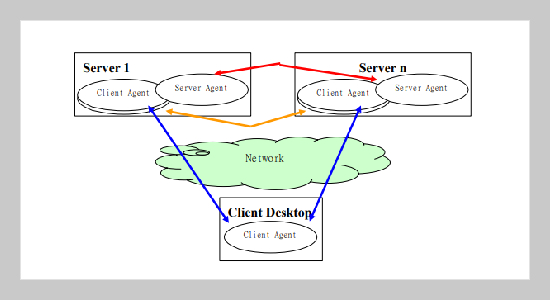REFERENCES
- [1] Software Agents Group at MIT Media Lab: http://agent.www.media.mit.edu/v groups/agents/.
- [2] UMBC Intelligent Software Agents Resources: http://www.cs.umbc.edu/agents/.
- [3] Charlton, P., Chen, Y., Mamdani, E., Olsson, O., Pitt, J., Somers, F. and Wearn, A., “An Open Agent Architecture for Integrating Multimedia Services,” Proceedings of the Autonomous Agents 97 Conference, Marina Del Rey, CA, U. S. A., pp. 522-523 (1997).
- [4] Chanda, D. and Martin, F., “Information Agents for Automated Browsing,” Proceedings of the 1996 ACM CIKM Conference (CIKM'96), Rockville, MD, U. S. A., pp. 296-305 (1996).
- [5] Alper, C. and Colin, H., Agent Sourcebook: A Complete Guide to Desktop, Internet, and Intranet Agents, Wiley Computer Publishing, (1997).
- [6] McKay, D., R, Fritzson, McEntire, and Finin, T., “KQML as an Agent Communication Language,” Proceeding of the Third International Conference on Information and Knowledge Management (CIKM), pp. 456-463 (1994).
- [7] McGilton and Gosling, “The Java Language Environment: A White Paper,” Mountain View, Sun Microsystems, CA, U.S.A., (1995).
- [8] “The Component Object Model Specification” http://www.microsoft.com, Microsoft Corporation and Digital Equipment Corporation, (1995).
- [9] Ousterhout, J. K., “Tcl: A Universal Scripting Language,” http://www.smli.com/research/ tcl.
- [10] White, J. E., ”A Introduction to Safety and Security in Telscript,” http://www.genmagic. com
- [11] Charlton, P., Chen, Y., Mamdani, E., Olsson, O., Pitt, J., Somers, F. and Wearn, A., “An Open Agent Architecture for Integrating Multimedia Services,” Proceedings of the Autonomous Agents 97 Conference, Marina Del Rey, CA, U.S.A., pp. 522-523 (1997).
- [12] Chanda, D. and Martin, F., “Information Agents for Automated Browsing,” Proceedings of the 1996 ACM CIKM Conference (CIKM'96), Rockville, MD, U. S. A., pp. 296-305 (1996).
- [13] Robert, S. G., “Agent Tcl,” Dr. Dobb's Journal of Software Tools for Professional Programmer, Vol. 22, 18-26 (1997).
- [14] Joseph, K. and Daniel, Z., “Hands-on Look at Java Mobile Agents,” IEEE Internet Computing, Vol. 1, pp. 21-30 (1997).
- [15] David, K., Robert, G., Saurab, N., Daniela, R., Sumit, C. and George, C., “Agent Tcl: Targeting the Needs of Mobile Computers,” IEEE Internet Computing, Vol. 1, pp. 21-30 (1997).
- [16] Krause, S. and Magedanz, T., “Mobile Service Agents Enabling Intelligence on Demand in Telecommunications,” Proceedings of the 1996 IEEE Global Telecommunications Conference, London, U.K., pp. 78-84 (1996).
- [17] Jide, B. O., David, J. K., Stuart, M. W., Nagi, W., Sadanand, S., Chris, G. and JoAnna, G., “SAIRE-A Scalable Agent-Based Information Retrieval Engine,” Proceedings of the Autonomous Agents 97 Conference, Marina Del Rey, CA, U.S.A., pp. 292-299 (1997).
- [18] Michael, P. and Daniel, B., “Learning and Revising User Profiles: The Identification of Interesting Web Sites,” Machine Learning, Vol. 27, pp. 313-331 (1997).
- [19] Charles, J. P., “Agent-based Engineering, the Web, and Intelligence,” IEEE Expert, Vol. 11, No. 6, pp. 24-29 (1996).
- [20] Peter, S. S. and Peter M. B., “WAVE: Mobile intelligence in open networks,” Proceedings of the 1996 1st Annual Conference on Emerging Technologies and Applications in Communications, Portland, OR, U.S.A., pp. 192-195 (1996).
- [21] Ruud, S., Owen, H., and Janet, B., “Ant-like Agents for Load Balancing in Telecommunications Networks,” Proceedings of the 1997 1st International Conference on Autonomous Agents, Marina Del Rey, CA, U.S.A., pp. 209-216 (1997).
- [22] Joseph, T. and Luis, V., “Mobile Agent Security and Telescript,” Proceedings of the 1996 41st IEEE Computer Society International Conference (COMPCON'96), Santa Clara, CA, U.S.A., pp. 58-63 (1996).
- [23] Chirstph, G. T. and Gerhard, F., “Using Agent to Personalize the Web,” Proceedings of the 1997 ACM IUI Conference (IUI'97), Orlando FL, U.S.A., pp. 53-60 (1997).
















